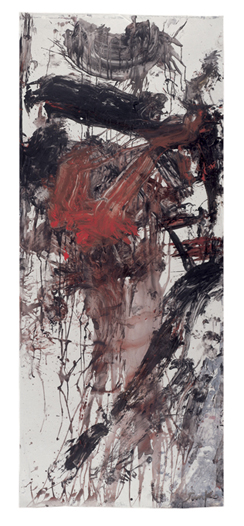 |  |
 |
| | |
| |
|
|
| |
|
|
|
|
|
| Junko's art is reminiscent of the art of the "spiritual" artists of the 20th Century: she was certainly influenced by Roualt, Van Gogh, Kandinsky, Klee, Mondrian, and Picasso. But her work exhibits a contemporary spirituality which grows out of the shared experience of the twentieth century and which is honest to our age. Multiculturalism is an important part of that shared experience. |
| | | From Chapter 4, pp. 162-163, The Impact of Multiculturalism. |
| | |  |
| | | In the Forest of Amida Buddha, No. 24 (1993), Sumi and Acrylic on mylar, 80x42" |
| | | The early spiritual artists were very much European, and their acquaintance with cultures outside Europe was generally superficial. As a consequence, their incorporation of “primitive”, or Egyptian, or “Eastern” images into their art is often sentimental: a kind of exoticism. All those artists lived in the days when Europeans assumed that Europe was the center of culture, and when cultural exchange was essentially a voluntary thing. For us, living through the last half of the 20th Century, cultural exchange is not optional: we live shoulder to shoulder with other cultures and sometimes, as Junko and I have done, we intermarry and face the gap between cultures every single day. There are families in our large cities in which three different languages must be spoken: one in which the husband communicates with his wife, another in which he communicates with the children, and yet another in which the wife communicates with the children. That is the world we live in, and the “Euro-centrism” of those earlier artists seems now to be nothing more than a set of childish prejudices. |
| But there are other aspects to multiculturalism that the earlier generations never appreciated: its difficulty and the pain it causes. Right up to the 1960s, openness to other cultures was seen as a positive, happy thing: it was associated with an affirmation that we are all members of “The Family of Man.” Even in today’s world, for many people who live in the developed countries, travel and visiting other cultures, or witnessing local public displays of foreign cultural identity (such as Cinquo de Mayo or the Chinese New Year celebrations), is seen as a form of recreation analogous to visiting a museum. But Junko’s experience of multiculturalism is deep, personal, and painful. |
| Every culture has a strong tendency to make the people who are born into it believe that there are absolute values in it, and that those values are universal. The process of accepting cultural relativity involves shaking one’s faith and identity and so, when representatives of two different cultures live together, the encounter can be painful for both parties: it often arouses anger and hostility. Junko’s struggle with multiculturalism brought her to a completely new and unexpected level of understanding of what it involves. In Japan she was a member of the elite. Although she had to struggle hard to individuate herself in that totalitarian society, she still was unquestionably a member of the powerful social majority. But once she came to America and started to live here as an immigrant, almost overnight she found herself to be a member of an under-privileged minority. There were not only ethnic and cultural differences: as a person who has a handicap in expressing herself in our language, she became a member of a powerless minority. Life turned upside down. At a lecture she gave in 1999, at a conference on Exile sponsored by the Getty Museum, Junko said this about what she felt: |
| | | I started noticing the groups of people here who are minorities for one reason or another; because of language or ethnicity or age or because of some physical difficulty. All of them were living in the pain of not being accepted or respected in this society. I heard their unspoken cry of aspiration like the howling of a wolf, everywhere I saw them. I identified myself with them and with their cries. |
| |
| |
| |
|
|
|
|
|
|
|
|
|
|
|
| |
| |
|
| |